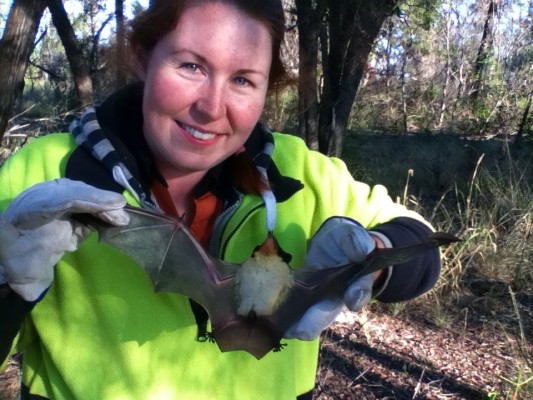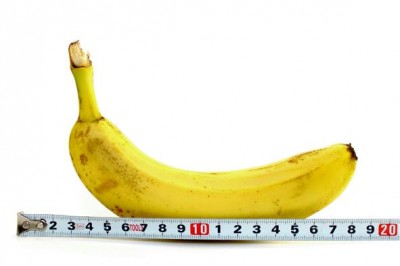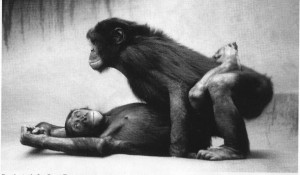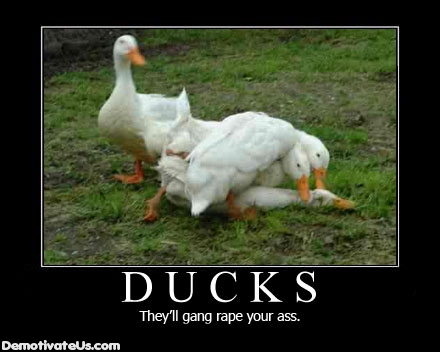my research project on sperm competition in bats
Hi folks – long time, no blog!
I have written before about the relationship between testes size and brain size in micro bats (aka echolocating, insect-eating bats as opposed to fruit or nectar eating bats). Many of you have also emailed me information about the scientific study that was published in 2006 by research team Pitnick et al. that first demonstrated this relationship. Thank you very much for that and in exchange I thought I might give you a bit of an update on what I am in the middle of doing to further our understanding of the brain-testes relationship in bats.
For my masters degree I am looking at whether or not there are any differences in the brain volume of male and female micro bats. I have been wondering if there might be ever since reading about Pitnick et al.’s study. My thinking was that if there is, indeed, some sort of inverse relationship in bats between brain size and testes size whereby the two metabolically expensive organs trade off against each other then it stands to reason that perhaps females could have larger brains than males since they don’t have testes competing with their brains for dominance in the body. At least, I thought, this might be the case in species where males have very small brains due to their enormous testes which hog all the body’s resources.
My study is fairly small in scale but I am hoping that it will still prove interesting. I am comparing averages of male and female brain volumes in 9 Australian micro bat species – some that have mating structures where females are promiscuous and some where females are loyal to a single mate (a dominant male harem leader). To do this we are CT scanning a collection of skulls and then using computer technology to create 3D models of the brains as a way to ascertain volume.
Here’s a picture of the first skull we scanned. It makes me laugh every time I look at it – such a big machine to scan such a tiny object (that little spot on the blue towel is the skull):
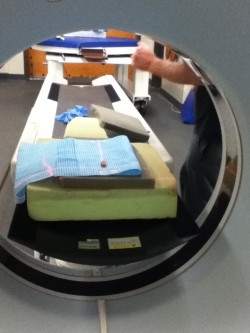
And here is a model I am putting together of that same skull. It needs work but it’s still pretty cool:
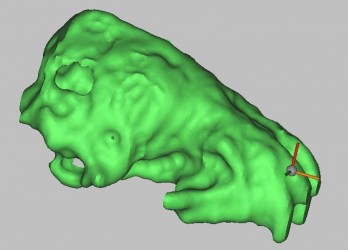
Interestingly, the factor that influences testes size in micro bats in female sexual behaviour. When females are highly promiscuous and take many sexual partners the males tend to have much larger testes than species where females are loyal to a single mate. It is assumed that the large testes trait develops in species where females are promiscuous because there is greater competition among sperm for access to the eggs in these individuals and so those males with more sperm available tend to be selected for over time. It is similar to how if you are really keen to win a meat raffle you will buy more tickets.
The same relationship between female promiscuity and testes size occurs in primates, including humans and for that matter, basically all animals. You can look at most any wild animal and get a good idea of the level of female promiscuity by looking at the testicles of the males. The difference with bats is that because bats weigh very little (as little as 2 grams!!) and have an extremely tight energy budget they cannot afford to have both heavy brains and heavy testes and so they trade one tissue type against the other.
Pitnick and his colleagues in their landmark study originally predicted that the opposite relationship would occur – ie that large brains would equal large testicles. They postulated that species with promiscuous females would have larger brains as a way for the males to avoid being cuckolded. They were surprised when they discovered that the opposite was true and remarked that “perhaps monogamy is more neurologically demanding.” I think many of us would attest to the truth of this statement!
If my study shows that there are any size differences in male and female bat brains as a function of testes size it may potentially mean that female promiscuity is a force strong enough to influence male intelligence in a measurable way. An intriguing notion but at this stage very much a theoretical one.
*Sidenote: the boys on the construction sites where I have been working have heard me talk about animal testicles so much that they have become terrified I’m going to show up at their bedroom door one day with my calipers! Actually that’s not completely true .. some have actually volunteered for the job! .. all in the name of science, right? 😉
** Oh and yes the bat in the picture above is alive! It was just very very cold because I pulled it from a tree which had just been buldozed on a construction site in the very early hours of a winter morning.

